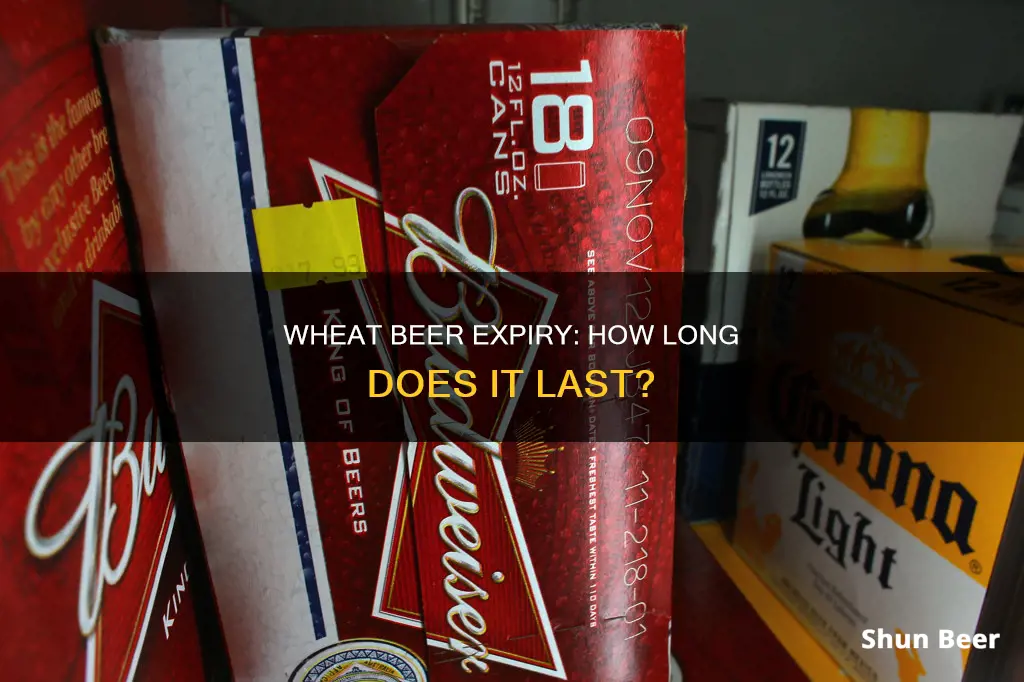
Beer is a perishable product that will eventually go bad. The speed at which this happens depends on a number of factors, including the type of beer, its alcohol content, and how it is stored. Wheat beer, like lager and IPAs, will start to lose its flavour after three to six months, but beers with a high alcohol content can be aged for years and will continue to taste good. Beer that is refrigerated will last longer than beer stored at room temperature, and beer stored in cans will last longer than beer stored in bottles due to the airtight seal of cans.
| Characteristics | Values |
|---|---|
| Does wheat beer expire? | Yes, wheat beer does expire. |
| Beer expiration time | Beer lasts for about 6-9 months beyond the dates on the label. Refrigeration increases this time period to up to two years. |
| How to identify expired beer? | You can usually tell when you open the bottle if your beer has expired. When you open the bottle, you should hear the normal "psssst" sound indicating that your beer is fresh and ready to drink. Lack of foam is an indication that the beer has gone bad. |
| Beer freezing | Beer can go bad if it freezes. Liquid expands when frozen, and the carbonation creates extra pressure that can cause the bottle to explode. |
What You'll Learn

Wheat beer is susceptible to skunking
Wheat beer, like any other beer, is susceptible to going bad. While it is alcohol and will not expire in the same way that food does, it can certainly expire in the sense that it will go bad and become undrinkable. One of the ways beer goes bad is by becoming "skunked". Skunking is a chemical reaction that occurs when beer is exposed to light, specifically UV rays. The UV rays penetrate the beer bottles and react with the iso-alpha acids, which are chemical compounds in hops, breaking them down and resulting in the creation of new compounds that give off the unmistakable skunk odour and taste.
Wheat beer is particularly susceptible to skunking because it is often bottled in clear or green glass bottles, which offer little to no protection against UV rays. Brown bottles provide the best protection against UV rays, followed by green bottles, while clear glass bottles offer no protection at all. The colour of the glass bottle interacts with UV rays and can either block or allow the passage of these rays, which then react with the beer.
To prevent wheat beer from skunking, it is important to store it in a dark place, away from direct sunlight. Keeping it in the refrigerator is ideal, as it provides a dark and cool environment. Additionally, storing bottles upright can help minimise oxidation and slow down the aging process.
Skunking is not the only way wheat beer can go bad. Other signs of expired wheat beer include a lack of foam when opened, a dusty bottle or discoloured label, seepage around the cap, a change in the colour of the beer, or a "dusty" settlement visible at the bottom of the bottle. These signs indicate that the beer has gone flat or spoiled.
It is worth noting that the expiration dates on beer are not set in stone. Proper storage can extend the shelf life of wheat beer beyond the expiration date. However, it is still best to consume it within a reasonable timeframe to ensure optimal freshness and flavour.
Exploring the World of Wheat Beers: Are All Brews Wheat-Based?
You may want to see also

Proper storage can extend the shelf life of wheat beer
Wheat beer, like all beer, is susceptible to deterioration over time. Proper storage can, however, extend its shelf life.
Enemies of Beer
There are several factors that can cause beer to degrade in quality over time. These include light, heat, and oxidation.
Light
Beer is susceptible to light exposure, particularly ultraviolet light. UV rays break down the essential oils in hops extracts, creating chemical compounds that are similar to those found in skunk spray. This process, known as "skunking," results in an unpleasant odor and taste. Brown bottles offer some protection against UV rays, while green bottles can block light below 400 nanometers (nm). Clear bottles, on the other hand, offer no protection against light strike.
Heat
Heat accelerates the chemical reactions that cause the breakdown of molecules in beer. This leads to faster aging and the production of undesirable compounds. Exposure to high temperatures can also cause the breakdown of yeast, resulting in a flavor and aroma similar to burning tire rubber.
Oxidation
Oxidation is the process by which oxygen interacts with the chemical compounds in beer, causing alterations in flavor and aroma. It can result in the formation of diacetyl, which adds a buttery flavor, or other compounds that contribute to cardboard or musty flavors.
Proper Storage Practices
To extend the shelf life of wheat beer, the following storage practices should be implemented:
Store in a Cool, Dark Place
Keeping wheat beer in a cool, dark place is crucial. Refrigeration is ideal, as it slows down natural aging processes. If refrigeration is not possible, store the beer in a cool room with minimal temperature changes and no direct sunlight.
Use Opaque Containers
Wheat beer should be stored in containers that block UV light. Brown bottles are preferable to green or clear bottles, as they minimize the effects of light strike. Cans are also an excellent option, as they completely block out direct sunlight and seal out oxygen and contaminants.
Store Upright
Storing wheat beer upright is important for two reasons. Firstly, it minimizes the amount of beer exposed to oxygen, slowing down the oxidation process. Secondly, it prevents the creation of a yeast ring (or watermark) inside the bottle from dead yeast cells.
Maintain Consistent Temperatures
Fluctuations in temperature are not ideal but will not cause significant harm to the beer. However, it is essential to avoid extreme temperatures and heat. A good rule of thumb is to never leave your beer anywhere you wouldn't leave your dog.
Check the Container and Pasteurization
While brown bottles are preferable, many mass-produced beers are sold in green or clear bottles. Check the storage container and be aware that these may have a shorter shelf life due to increased UV exposure. Additionally, check if the beer has been pasteurized, as this will impact its shelf life.
By following these proper storage practices, you can effectively extend the shelf life of wheat beer and enjoy it at its freshest and most flavorful state.
Dark Beers and Wheat: What's the Connection?
You may want to see also

Wheat beer is best stored upright
Like any food, beer is an organic substance that will eventually decay. Wheat beer is best stored upright to decrease the oxidation process and prevent contamination from the cap.
Oxidation is a natural aging process that alters the flavour and aroma of beer. As oxygen interacts with the chemical compounds in the beer, it breaks them down, resulting in different flavours. Diacetyl, for example, adds a buttery flavour to the beer. Because oxidation is caused by air leakage, bottled beers may be more susceptible to this issue than cans, which have a tighter seal.
Storing beer upright minimises the amount of beer in contact with the air, slowing the aging process. If stored on their sides, the amount of surface area for oxidation is maximised.
To prevent flavour loss and ensure your beer tastes as it should, keep bottles at a steady 50 to 55 degrees Fahrenheit. This is known as "cellar temperature". A good beer fridge will also protect bottles from damaging UV rays.
Wheat beers, in particular, are susceptible to warm storage, which can affect their flavour. Refrigeration is a good way to help beer last as long as possible, as it provides a dark and cool place.
Pale Ale Beer and Wheat: What's the Connection?
You may want to see also

Wheat beer is best stored in a cool, dark place
Wheat beer, like any other beer, is susceptible to decay and will eventually go bad. To prevent this from happening, it is important to store it correctly.
Firstly, it is important to control the temperature at which the beer is stored. The ideal temperature for storing wheat beer is between 40 and 50 degrees Fahrenheit. This temperature range is colder than room temperature but not as cold as a refrigerator. Storing wheat beer at this temperature will slow the decay of the beer and preserve its flavour.
Secondly, it is important to protect the beer from light exposure. Ultraviolet light can cause a chemical reaction in the beer, breaking down important flavour compounds and causing it to taste and smell like skunk spray. To avoid this, wheat beer should be stored in a dark place, away from direct sunlight.
Thirdly, it is important to minimise oxidation by storing the beer upright, thereby reducing the amount of beer in contact with the air. This will slow the aging process and help to preserve the flavour of the beer.
By following these guidelines, you can help ensure that your wheat beer stays fresh and flavourful for as long as possible.
Carlsberg Beer: Wheat-Free or Not?
You may want to see also

Wheat beer can be drunk past its expiration date
Beer is susceptible to light exposure, oxygen exposure, and bacteria exposure, which can affect its taste and quality. Ultraviolet light can cause a chemical reaction with the hops in beer, resulting in an unpleasant skunky odour and taste. Oxidation, caused by air leakage, can alter the flavour and aroma of beer, leading to different flavours such as buttery or cardboard-like tastes. Bacteria can also contaminate beer, although this is less common in commercially sold beer due to brewers' efforts to minimise contamination.
To extend the shelf life of wheat beer, it's important to store it properly. Beer should be kept in a cool, dark place, away from direct sunlight and temperature fluctuations. Storing beer upright can also help minimise oxidation. Additionally, choosing beer packaged in brown glass bottles or cans can provide better protection against light exposure.
While wheat beer can be consumed past its expiration date, it's important to consider the potential impact on taste and quality. Checking for signs of spoilage, such as unusual odours or flavours, discolouration, or excessive sediment, is crucial before consuming expired beer.
The Pilsner and Wheat Beer Divide: What Sets Them Apart?
You may want to see also
Frequently asked questions
Yes, all beer has a shelf life and will expire.
Beer typically lasts for six to nine months beyond the expiration date on its label. Refrigeration increases this time period to up to two years.
Some signs that your wheat beer has expired include a lack of foam when you open the bottle, a discoloured label, seepage around the cap, a change in the colour of the beer, or a dusty settlement visible at the bottom of the bottle.







